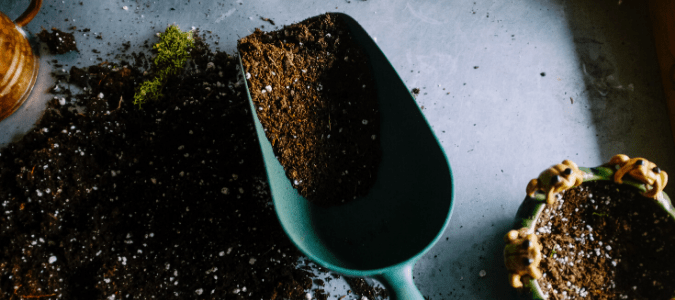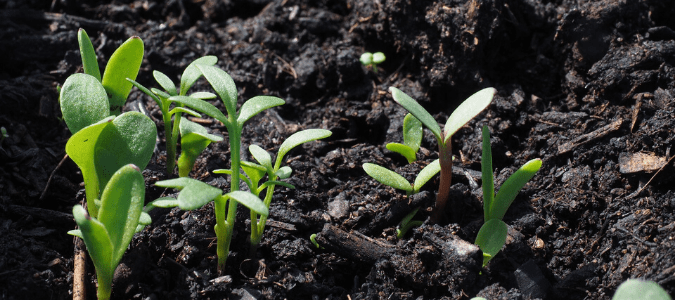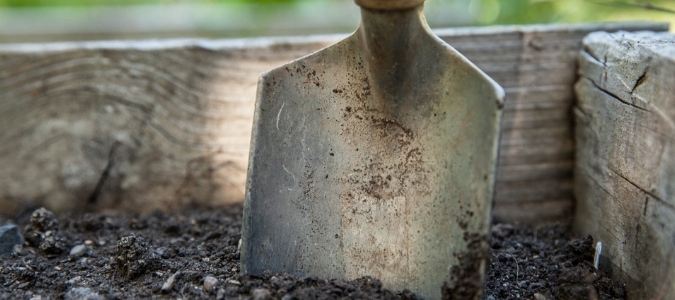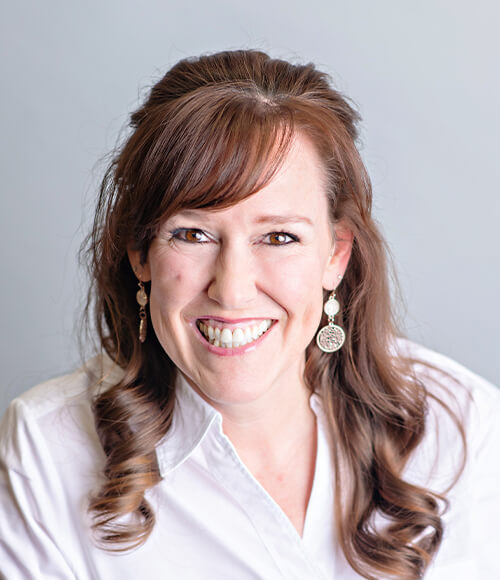
Many people have questions about topsoil versus compost—namely, what exactly are they, what are the differences between them and which is best for growing beautiful flowers or thick, lush grass. Whether you’re planting a garden or simply looking for ways to help your lawn thrive, you’ve probably considered both topsoil and compost as a lawn amendment, and you might have felt confused about which would be best for your yard’s particular needs. Topsoil and compost are similar in appearance, after all—they both look a lot like regular dirt. But they aren’t the same, and while both play important roles in creating outdoor spaces that thrive, they have distinct uses and applications.
Put very simply, topsoil is the very topmost layer of soil on the ground. When people add it to their yards or gardens as a soil amendment, they usually purchase it in bags or in bulk, although you can create your own topsoil by gathering soil from various parts of your yard and mixing it with compost for use on grass or in your garden. Topsoil can have a variety of consistencies and ingredients depending on where it was gathered. For example, it might be sandy or might have a more clay-like consistency; if it’s bagged, it might also have had fertilizer or lime added to it.
By virtue of what topsoil is, it is typically richer with nutrients and organic materials than soil found deeper below the surface of the earth, though it can be depleted over time if it isn’t amended and improved. Topsoil has a variety of uses and purposes, including improving drainage issues and leveling low spots in your lawn, or mixing into existing soil before planting a new garden in order to prepare the soil for maximum growth potential.
The simplest definition of compost is that it is decomposing organic matter. Like topsoil, compost can be purchased in bags or in bulk; you can also easily create your own, though this process does take time—a minimum of weeks or months, depending on how you build your compost and how often you water and turn it. Compost can be made up of lots of different types of organic matter, including yard trimmings like leaves and grass, and food scraps from your kitchen, such as fruit and vegetable scraps, coffee grounds, used paper towels and more.
Before adding any new soil or nutrients to your landscape, it’s a smart idea to test a sample of your soil. This will tell you the soil’s pH balance and nutrient content, so you’ll know which nutrients and minerals are needed for your lawn or garden to flourish. Soil test kits are available for purchase at your local gardening or home improvement store.
You can also conduct your own soil pH test without a kit, using just a bit of vinegar and baking soda, to get a general idea of whether the soil in your yard is acidic, alkaline or neutral. Having this information can guide you as to which flowers or vegetables are most likely to do well in your yard. It’s best to test soil in the fall, so you can amend it either just before winter hits or first-thing in the spring, before new grass and plant growth begin.
As far as whether to use topsoil or compost in your yard, or a combination of the two, it depends on your particular landscaping or gardening needs. If you’re trying to grow a thick, lush carpet of grass, both topsoil and compost can be effective. Either one can be used to address bald spots in your lawn, by adding two to three inches’ worth of topsoil or compost to the area and incorporating it into the existing soil to encourage grass growth over time. Topsoil can also be added to low spots in the lawn to level the grass, which will grow up through it to the surface.
To generally improve an existing lawn, you can spread a half-inch-thick layer of compost over the entire yard to add nutrients to the soil. If you are planning to lay down new sod or plugs or to overseed your lawn, you can combine topsoil with compost and work a layer of the mixture into the existing soil to prep it for growth. Plan to lay down several inches’ worth of the topsoil and compost mixture to create the right base for your new lawn.
If you’re planting or refreshing a flower or vegetable garden, you can add two inches’ worth of topsoil to a garden bed and mix it into the top two inches of the existing soil to enrich the soil and prepare it for planting. You can also use compost as mulch in a garden bed or around trees, to act as a weed barrier while holding in moisture and protecting plant roots from extreme temperatures.
Many people prefer to reach out to a lawn care specialist for help, both with knowing which products to use and when, as well as with the physical labor that gardening and lawn care require. A knowledgeable lawn care technician can help by testing the soil in your yard to determine its mineral content and pH balance, so the right nutrients can be added in the proper proportions to beautify your grass and garden beds. A landscaping professional can also recommend topsoil, compost or a mixture of both according to your yard’s particular needs. Finally, these professionals can implement a lawn care schedule that is customized to your yard, to ensure that your outdoor space stays gorgeous and thriving from one season to the next.
If you want to go the do-it-yourself route, you’ll need a bit more information. Keep reading to learn about how much topsoil you will need for your particular yard as well as how to use compost.

How Much Topsoil Do I Need?
This answer depends on the square footage of the space you’ll be dressing with topsoil, as well as the effect you’re trying to achieve. If you’re trying to enrich your soil to encourage growth in your lawn or garden beds, you should plan for about a half-inch of topsoil depth spread out over the entire area of yard that you’re trying to improve. If you’re planning to lay down new sod, plugs or seed, on the other hand, you’ll need to work several inches’ worth of topsoil mixed with compost into the top two or three inches of existing soil, to create the enriched soil base that will promote thick, green grass growth.
The simplest way to calculate how much topsoil you’ll need to use for your yard is to first calculate the square feet of the area you’re amending. You can do this with a measuring tape or simply by pacing it off (the average length of an adult’s walking stride is two and a half feet). Once you know the square footage of the area you’re planning to dress with topsoil, you can then calculate the total amount of topsoil needed by multiplying the square feet by the depth, in inches, that you’ll be using—somewhere between a half-inch and four inches, depending on your project.
Topsoil is sold in bulk in cubic yards, or in bags with contents that are measured by cubic feet; as a general rule of thumb, you would need 12 cubic yards of topsoil to cover 1,000 square feet of yard at a depth of four inches. You can also rely on a lawn care specialist to make these technical determinations, along with specialized recommendations about whether topsoil or compost would better suit your yard’s particular needs. Then, these specialists can take on this yard care task for you.

How to Use Compost
If you aren’t sure how to apply compost to your grass and plants for maximum benefit, you’re in luck, because it’s pretty easy to learn—both how to make compost and how to use compost to help your lawn or garden flourish. At its simplest, compost is just various types of organic matter (such as grass clippings, yard trimmings, dead leaves and kitchen scraps) that have decomposed into a nutrient-rich, soil-like substance that promotes new plant growth. This decomposed substance can be mixed in as an amendment for topsoil or potting soil, or it can be used in place of mulch in garden beds or around the base of trees to protect the plants’ roots, hold moisture in and deter weed growth.
A simple composting method that almost anyone can implement involves only fallen leaves and grass clippings from your yard, plus air and water. All you need is a contained space (ideally three feet by three feet cubed) that is open to the air, where you can toss the leaves, clippings and other organic items you may have picked up during your landscaping cleanup, and periodically water it down and turn it over with a shovel. You’ll know your compost is ready to use when it looks like dirt, rather than like the original materials that went into it.
This method is great for novice gardeners because it’s easy to do, and since it doesn’t contain food scraps, it won’t stink or attract pests or vermin. Plus, by leaves, bark and other brown matter with fresh grass clipping, plant trimmings and other green matter, you’re creating a compost that’s rich with the nitrogen and carbon needed to enrich the soil and help your lawn thrive. Just keep in mind that composting oak leaves and some other plant materials can take some time, so you’ll have to see which materials break down fast enough to suit your needs.
To plant with compost, spread a half-inch-thick layer over your grass and water it in to add nutrients to the soil, or mix it in with topsoil before laying down new sod, plugs or grass seed. You can also use compost in a flower or vegetable garden to help it grow and thrive. A lawn care specialist can also be instrumental in the best uses of compost in your yard or garden, and can also help you determine if compost or mulch would be better for your situation. These landscaping professionals can determine which type of compost to use in your yard and how much, and can also determine a schedule for reapplying compost as needed according to your region’s temperatures and rainfall. Or, if you would prefer a lower-maintenance yard, a landscaping professional can advise you on native plants that require less watering, nutrients and care, refresh your landscaping seasonally or add in texture and height with shrubs and small trees.
ABC Can Fertilize Your Landscape
There are a lot of considerations to take into account when it comes to properly caring for your yard. Instead of spending your free time trying to determine how to get your plants the nutrients they need, rely on ABC Home & Commercial Services. Our lawn care specialists are familiar with how our local conditions can affect your soil and will be able to implement a yard care schedule that keeps your lawn and plants healthy. With ABC’s help, your curb appeal can look great, without your having to lift a finger.
